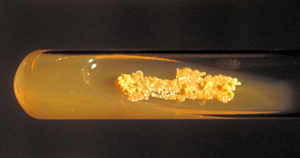Nocardia
| Nocardia | ||||||||||||
|---|---|---|---|---|---|---|---|---|---|---|---|---|

Colonies of Nocardia asteroides |
||||||||||||
| Systematics | ||||||||||||
|
||||||||||||
| Scientific name | ||||||||||||
| Nocardia | ||||||||||||
| Trevisan 1889 |
Nocardia (named after the French infectiologist Edmond Nocard ) are rod-shaped, gram-positive bacteria. They often grow branched and in some cases, like mycobacteria, cannot be decolorized by acid (acid-proof). Nocardia occur ubiquitously in the soil and in humid habitats. They grow particularly well at 30 ° C, and some can cause an acute or chronic infectious disease ( nocardiosis ) in humans and animals . Like the anaerobic pathogens of actinomycosis , the aerobic nocardiosis pathogens used to be counted as "radiation fungi " in the Actinomycetaceae family .
species
Some types of Nocardia with the type species Nocardia asteroides (Eppinger 1891) Blanchard 1896:
- Nocardia abscessus Yassin et al. 2000
- Nocardia araoensis Kageyama et al. 2004
- Nocardia brasiliensis (Lindenberg 1909) Pinoy 1913
- Nocardia brevicatena (Lechevalier et al. 1961) Goodfellow and Pirouz 1982
- Nocardia concava Kageyama et al. 2005
- Nocardia elegans Yassin and Brenner 2005
- Nocardia inohanensis Kageyama et al. 2004
- Nocardia paucivorans Yassin et al. 2000
- Nocardia terpenica Hoshino et al. 2007
Other Nocardia species:
- Nocardia flava
- Nocardia citrea
- Nocardia lutea
- Nocardia nigra
- Nocardia albicans
- Nocardia madurae
Diseases (nocardiosis)
Nocardia, often Nocardia farcinica and N. asteroides in Germany and N. brasiliensis outside Europe or from potting soil of tropical houseplants, are absorbed through the lungs. In humans, only systemic diseases of immunosuppressed people are known to be caused by this pathogen. First of all pulmonary nocardiosis with bronchopneumonia and lung abscess occurs . From there, they can spread to various organs via the blood ( hematogenous ) (systemic nocardiosis). The pathogens preferentially attack the CNS and trigger encephalitides and brain abscesses . Nocardia can also cause cutaneous and subcutaneous abscesses (superficial nocardiosis, which also occurs in people with poor immune systems, especially farm workers and gardeners as an occupational disease). The latter is mainly caused by N. brasiliensis .

therapy
Antibiotic therapy against Nocardia farcinica and N. asteroides with imipenem and amikacin (alternatively linezolid or the fixed combination amoxicillin / clavulanic acid ), against N. brasiliensis and N. otitidiscaviarum cotrimoxazole and amikacin (alternatively amikacin and minocycline ). According to other sources, cotrimoxazole and doxycycline are used against nocardiosis and imipenem and amikacin as reserve antibiotics.
literature
- Martin Dworkin, Stanley Falkow, Eugene Rosenberg, Karl-Heinz Schleifer , Erko Stackebrandt (eds.): The Prokaryotes , 3rd edition, Vol. 3: Archaea. Bacteria: Firmicutes, Actinomycetes . Springer Verlag, New York 2006, ISBN 978-0-387-25493-7 (print), ISBN 978-0-387-30743-5 (online).
- Marianne Abele-Horn: Antimicrobial Therapy. Decision support for the treatment and prophylaxis of infectious diseases. With the collaboration of Werner Heinz, Hartwig Klinker, Johann Schurz and August Stich, 2nd, revised and expanded edition. Peter Wiehl, Marburg 2009, ISBN 978-3-927219-14-4 , p. 221 ( Nokardiosen ).
- B. Brown-Elliot, JM Brown, PS Conville, RJ Wallace: Clinical and laboratory features of the Nocardia spp. Based on current molecular taxonomy. In: Clin. Microbiol. Rev. Volume 19, 2006, pp. 129-282.
Individual evidence
- ↑ Hans von Kress (ed.): Müller - Seifert . Pocket book of medical-clinical diagnostics. 69th edition. Published by JF Bergmann, Munich 1966, p. 1062.
- ↑ Karl Wurm, AM Walter: Infectious Diseases. In: Ludwig Heilmeyer (ed.): Textbook of internal medicine. Springer-Verlag, Berlin / Göttingen / Heidelberg 1955; 2nd edition, ibid. 1961, pp. 9-223, here: p. 212.
- ↑ Hans von Kress (ed.): Müller – Seifert. Pocket book of medical-clinical diagnostics. 1966, p. 1062.
- ↑ Marianne Abele-Horn (2009), p. 221.
- ↑ Marianne Abele-Horn (2009), p. 221.
- ↑ Marianne Abele-Horn (2009), p. 221.